Analysis of the typhoon wave distribution simulated in WAVEWATCH-III model in the context of Kuroshio and wind-induced current*
HU Yuyi , SHAO Weizeng , , SHI Jian , SUN Jian , JI Qiyan , CAI Lina
1 Marine Science and Technology College, Zhejiang Ocean University, Zhoushan 316022, China
2 College of Meteorology and Oceanography, National University of Defense Technology, Nanjing 210007, China 3 Physical Oceanography Laboratory, Ocean University of China, Qingdao 266100, China
Abstract To investigate the relationship between surface currents and wave distributions in typhoons, we took the Typhoon Talim in 2017 as a case, and found that the track of the typhoon winds up to 50 m/s was almost consistent with the Kuroshio track, particularly from September 13 to 16, 2017. The surface current data, derived from the NCEP Climate Forecast System Version 2 (CFSv2) from the National Center of Atmospheric Research (NCAR), revealed that the speed of the wind-induced current exceeded that of the Kuroshio in the region with the maximum wind speed. In this study, was utilized a third-generation numeric wave model, WAVEWATCH-III (the latest version 5.16), developed by the National Oceanic and Atmospheric Administration (NOAA), to simulate the wave fi elds of Typhoon Talim using the European Centre for Medium-Range Weather Forecasts (ECMWF) reanalysis wind data in 0.125°×0.125° grid as the forcing fi eld. We found that the root-mean-square error (RMSE) of the signifi cant wave height (SWH) was 0.34 m when validated against measurements from altimeter Jason-2. In addition, we discovered that the SWH had a similar tendency to the change in the surface current speed that was approximately 0.5 m/s at the beginning of Typhoon Talim. However, the relationship became weak as the surface current speed was below 0.2 m/s. Our fi ndings show that the distribution of typhoon waves is resulted from the interaction of surface current and the wind-sea portion of the wave system, since the distribution pattern of wind-sea is consistent with the surface current, and there is a weak relationship between surface current and swell.
Keyword: current; typhoon wave; WAVEWATCH-III model
1 INTRODUCTION
It is well known that the Kuroshio is an important current in the northwest Pacifi c Ocean. In particular, this current advects high-temperature and highsalinity seawater from low latitudes in the Pacifi c Ocean to high-latitude seas, which has a huge impact on the meteorology, and hydrology of the oceans in these sea regions. To date, many studies have focused on the characteristics of the Kuroshio, e.g., the interannual variability of its entry into the South China Sea (Caruso et al., 2006). However, the interaction between currents and waves has not been well studied, especially in extreme conditions. Therefore, in this casework, we investigated the relationship between the wave distribution in typhoons and surface currents, including the Kuroshio and wind-induced currents. The typhoon-induced currents occupy the main part in wind-induced currents.
A typhoon-induced wave is a major cause of marine disasters, especially in coastal regions. Numerical wave models, e.g., the Wave Model (WAM) (The WAMDI Group,1988), Simulating Waves Nearshore (SWAN) (Akpınar et al., 2012) and WAVEWATCH-III (WW3) (Kim and Lee, 2018), as well as satellite observations, e.g., altimeter (Li et al., 2018) and synthetic aperture radar (SAR) (Li, 2015), are commonly used in studies of typhoon waves. The WW3 model, which was developed by the National Centers for Environmental Prediction (NCEP) of the National Oceanic and Atmospheric Administration (NOAA), has a good performance record for its wave simulation mode, with explicit treatment of nonlinear terms (Jiang et al., 2017). Moreover, the latest WW3 model (version 5.16) provides 3 convenient packages for the solution of the non-linear term quadruplets in the wave propagation equation (The WAVEWATCH III Development Group, 2016). Until now, the WW3 model has been widely used for wave climate analysis (Gallagher et al., 2016), and it has been proved that this model has the capacity to simulate the waves of the Pacifi c Ocean (Bi et al., 2015; Zheng et al., 2016; Shukla et al., 2018), China Sea (He and Xu 2016; Zheng et al., 2018) and other critical seas (Gallagher et al., 2014; Guo et al., 2018). In particular, the WW3 model is also suitable for the study of typhoon waves (Sheng et al., 2018; Shao et al., 2018a). Moreover, the WW3 model provides a swap of the wave-current interaction, demonstrating that it has the capability to include the eff ect of currents.
Currently, most studies perform analyses of simulated typhoon waves (Fan et al., 2012; Montoya et al., 2013; Shao et al., 2018b), and the direct derivation of wave parameters, from satellite-based typhoon data (Shao et al., 2017; Ji et al., 2018), in which, to a certain extent, mesoscale dynamic processes, e.g., currents and eddies, are neglected. As proposed in Moon (2005), tides were found to be the most infl uential factor in modulating the mean wave characteristics in the Yellow and East China seas. The study by Cui et al. (2012) included a sensitivity analysis on the eff ect of ocean currents on typhoonwave modeling in East China Sea, and their results revealed sea surface currents have an eff ect on typhoon wave simulation. However, there have been few studies concerning typhoon waves in the open sea, where the sea surface currents play an important role, e.g., the Kuroshio and wind-induced currents.
Interestingly, the track of Typhoon Talim in 2017 was almost consistent with the Kuroshio track in the northwest Pacifi c Ocean. The typhoon lasted for 14 d and the minimum pressure dropped to nearly 940 hPa with wind speeds up to 50 m/s. Therefore, as a valuable case study, in this work, our goal was to investigate the performance of typhoon-induced waves within the context of the Kuroshio and a strong wind-induced current. The typhoon wave fi eld was simulated using the latest WW3 model (version 5.16), and the simulated signifi cant wave height (SWH) was validated against measurements from altimeter Jason-2. We then analyzed the relationship between background current and simulated typhoon wave distribution for the case study.
The remainder of this manuscript is organized as follows: data collection is introduced in Section 2; a description of the WW3 model and model setup are briefl y described in Section 3; results are presented in Section 4; and the conclusions are summarized in Section 5.
2 DATA COLLECTION
The typhoon data are provided by the Regional Specialized Meteorological Centre (RSMC), Tokyo-Typhoon Center of the Japan Meteorological Agency (JMA), which off ers tropical cyclone information from the northwest Pacifi c Ocean. This information shows that Typhoon Talim existed from September 8 to 22, 2017. The tracks and maximum wind speeds of the typhoon associated with the bathymetric topography of the typhoon area are exhibited in Fig.1a. The track of Typhoon Talim was clearly consistent with the fl ow of the Kuroshio. We also used the NCEP Climate Forecast System Version 2 (CFSv2) open-access surface current data from the National Center of Atmosphere Research (NCAR). The surface current fi eld was 0.5°×0.5° gridded from August 1, 2017 to October 1, 2018 at 6-h intervals. As an example, Fig.1b shows the CFSv2 surface current fi eld on September 16, 2017 at 06:00 UTC. Of note, the maximum wind speed (up to 50 m/s) occurred when Talim passed the region of maximum surface current speed. Therefore, we interpret that the cyclonic pattern (Fig.1b) is a wind-induced current, which exerted a more signifi cant eff ect than the Kuroshio in this region.
The European Centre for Medium-Range Weather Forecasts (ECMWF) now continuously provides global gridded atmospheric reanalysis data with a fi ne resolution of up to 0.125°× 0.125° at 6-h intervals, which can be freely accessed from public datasets. ECMWF reanalysis data are widely used for oceanographic studies (Moeini et al., 2010; He et al., 2018), e.g., ECMWF wave data were a valuable source for verifying the results of the WW3 model in our previous study (Fan et al., 2012). However, due to the lack of individual wind-sea and swell information in these datasets, ERA-Interim wave data are not applicable for wave distribution analysis. Therefore, we utilized the WW3 model to simulate the typhoon wave fi eld in this study, including total SWH, windsea SWH, and swell SWH.
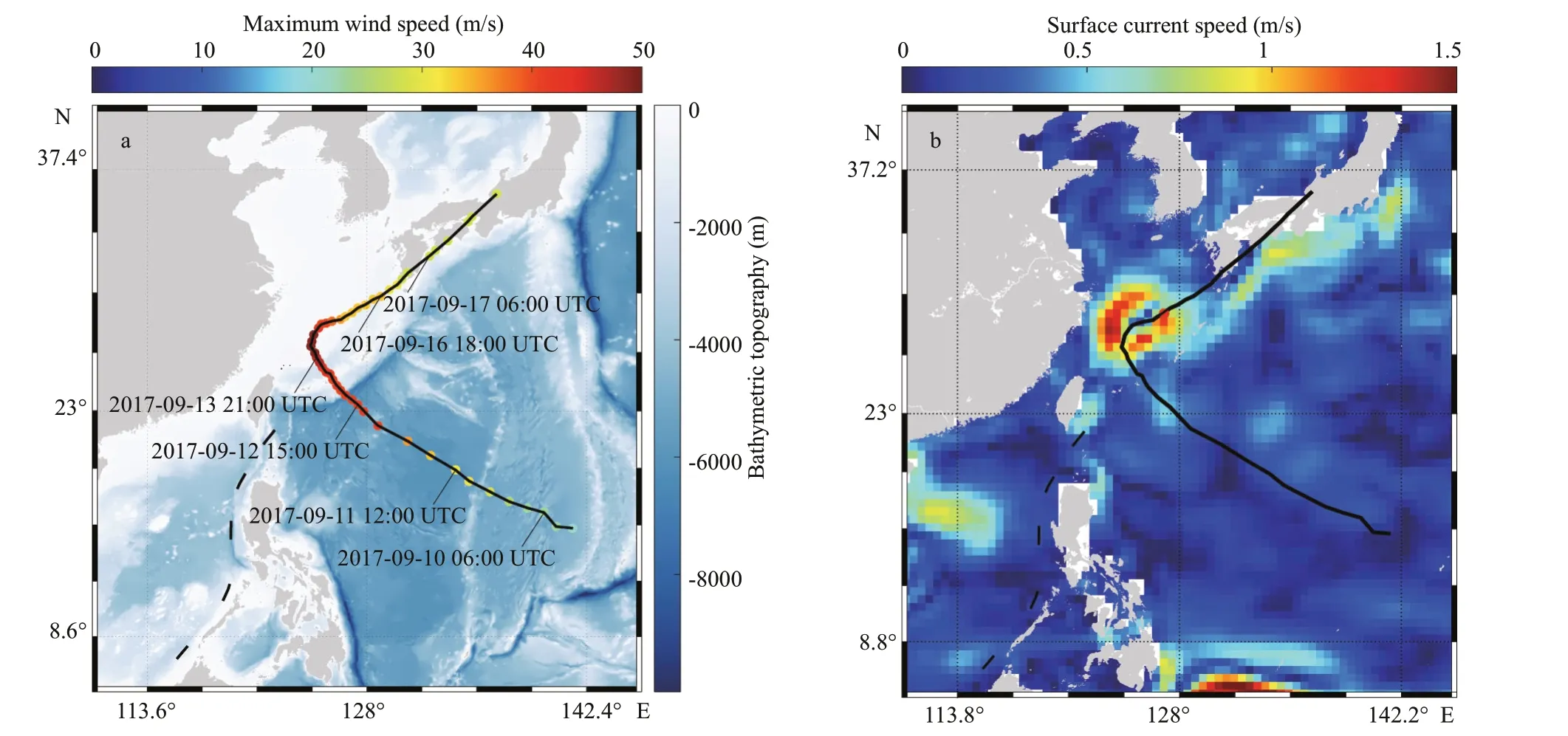
Fig.1 Bathymetric topography of the simulation area (a) and the map of NCEP Climate Forecast System Version 2 (CFSv2) currents (b) on September 16, 2017 at 06:00 UTC
The simulated area with 0.1°×0.1° gridded bathymetric topography from GEBCO (Weatherall et al., 2015) ranged from latitude 6°N to 44°N and longitude 111°E to 144°E. The model ran from August 1, 2017 to October 1, 2018. The ECMWF wind data on a 0.125° grid were taken as the forcing wind fi eld. We also collected the measurements from altimeter Jason-2, which is popularly employed to validate numerical model simulations (Liu et al., 2016). When we collect the altimeter Jason-2 data, covering the WW3-simulated grids, the time diff erence between altimeter Jason-2 and simulations from WW3 model is within 15-min since the output of the WW3 model is set at 30-min. There were more than 7 000 matching points crossing the simulated area during the simulation period. As an example, the WW3-simulated signifi cant wave height, overlaid by the matching points from altimeter Jason-2 on September 5, 2017 at 00:31 UTC is shown in Fig.2, in which the points from altimeter Jason-2 are represented by colored rectangles. The altimeter-measured data are clearly close to the simulation results from the WW3 model. Furthermore, a statistical comparison demonstrated that the WW3-simulated SWHs agreed well with measurements collected by altimeter Jason-2, resulting in an RMSE equal to 0.34 m with a 0.45 scatter index (SI), as shown in Fig.3. The SI calculation equation is,
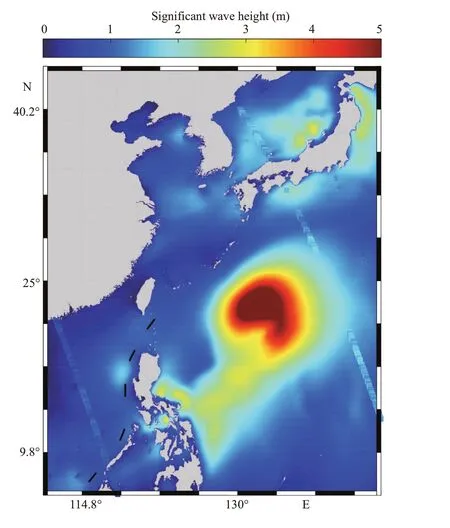
Fig.2 Map of WAVEWATCH-III (WW3) signifi cant wave height (SWH) overlaid by the points of satellite altimeter Jason-2 on September 5, 2017 at 00:31 UTC, represented by colored rectangles
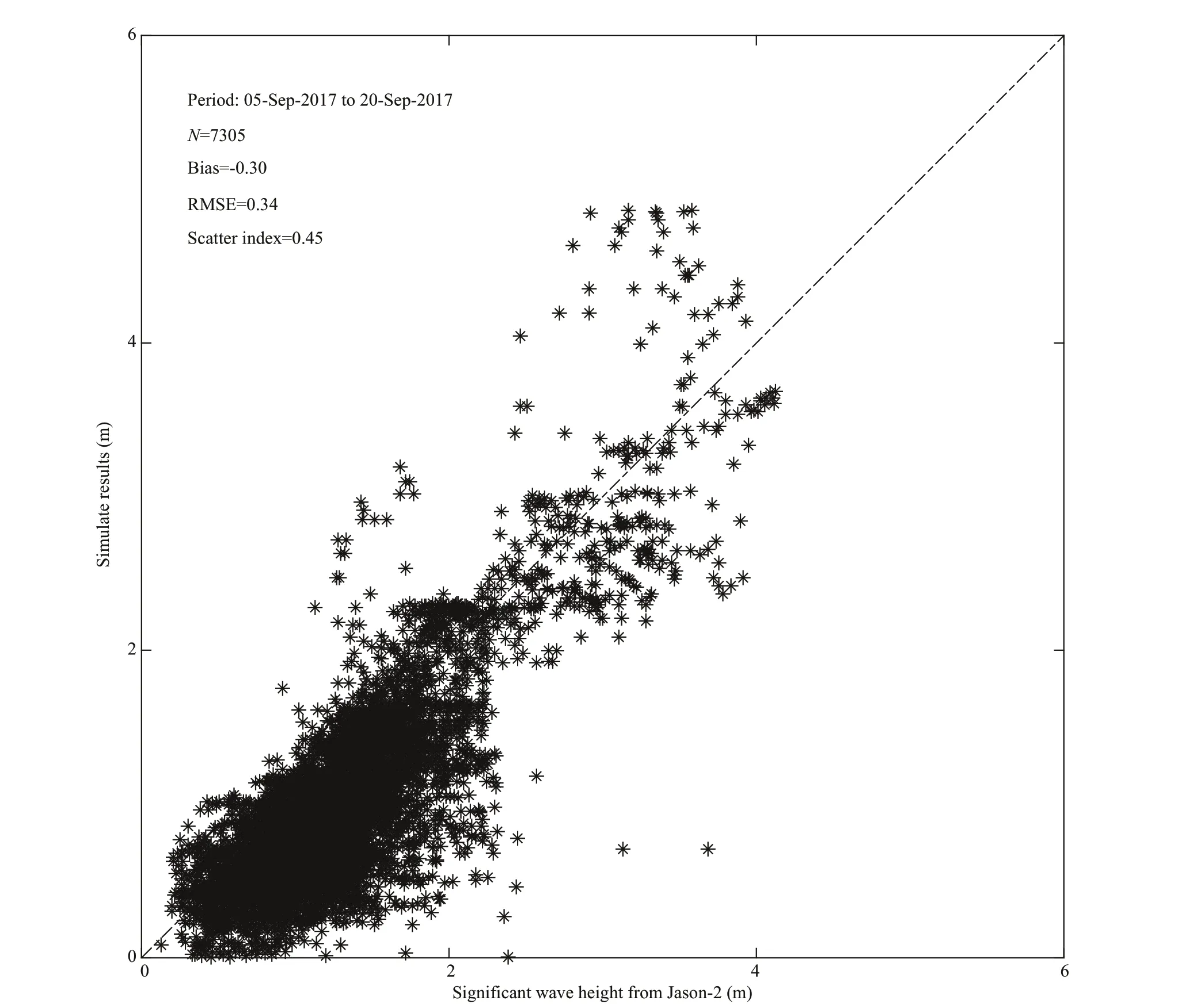
Fig.3 Comparison between the simulated results and measurements from altimeter Jason-2

We also found that WW3-simulate data generally underestimates the SWH, with a -0.30-m bias compared with altimeter measurements. This was probably caused by underestimated ECMWF winds, an interpretation that was consistent with the conclusion of Stopa and Cheng (2014). Regardless, we decided that the WW3-simulated wave fi elds could be reliable utilized in this study.
3 DESCRIPTION AND SETUP OF THE WW3 MODEL
In this section, we provide a brief description of the WW3 model and the regular model setup. In particular, the selected options of the model are described, e.g., the input/dissipation terms and the nonlinear 4-wave component (quadruplet) wave-wave interactions, which play an important role in typhoon wave simulation.
3.1 Options of the WW3 model
The WW3 model provides 7 input/dissipation terms, 4 nonlinear wave-wave interaction terms, and a nonlinear triad interaction. In our previous study (Shao et al., 2018b; Sheng et al., 2018), we found that these options were suitable for simulating the wave fi elds in Typhoon Talim, e.g., the input/dissipation terms, referred to as ST2 and STAB2, and the Discrete Interaction Approximation (DIA) of nonlinear wavewave interactions.
ST2 represents the input/dissipation term proposed by Tolman and Chalikov (1996). The atmospherewave interaction termSinis proportional to the wave action density spectrumN, stated as,
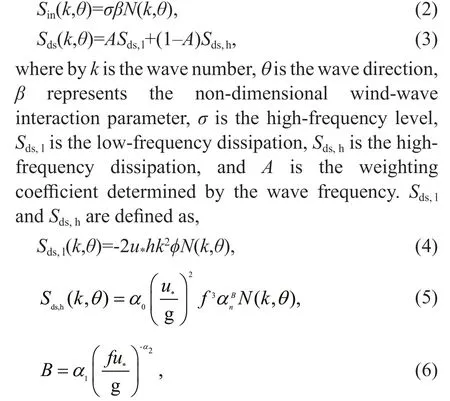
where,hrepresents a scale factor determined by the high-frequency intrinsic energy of the wave fi eld andφis an empirical function which refl ects the development stage of the wave fi eld;u*is the wind velocity as the forcing fi eld of the model;αnis a normalized Phillip’s non-dimensional high-frequency energy level;α0=4.8,α1=1.7×10-4, andα2=2.0.
STAB2 was devised by Tolman (2002) to stabilize the growth rate of deep-ocean waves in ST2. It primarily replaces the wind speedu*by an eff ective wind speedue, which is stated as:

where, ST is a stability parameter,Tais the air temperature,Tsis sea surface temperature,T0is the reference temperature, and default parameters ofc0=1.4,c1=-0.1,c2=0.1,c1=-0.1,f1=-150, and ST= -0.01 are implemented. It should be noted that the eff ective wind speed is measured at 10 m above the sea surface.
The DIA of the non-linear wave-wave interactions is a parameterization solution proposed initially in Hasselmann et al. (1985). The non-linear interactions are divided to quadruplets, with from wavenumber vectorsk1tok4. Under this condition,k1is assumed to be equal tok2. Furthermore, resonance conditions require quadruplets to satisfy the following:
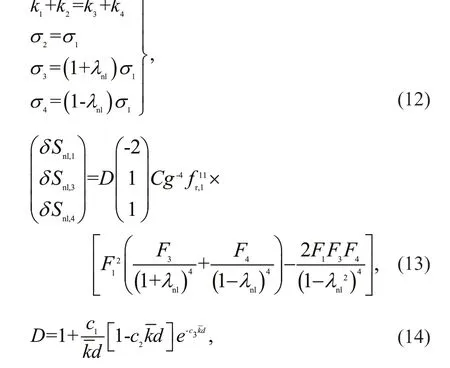
where,λnlis a constant 0.25, and the relative frequenciesσ1toσ4correspond to wavenumber vectorsk1tok4, respectively;δSnlrepresents the contribution to the interaction for each discrete spectrumF(fr,θ) combined with frequency and direction, and Eq. (The WAVEWATCH III Development Group, 2016) corresponds to wavenumberk1,F1=F(fr,1, θ),F(fr,2,θ),…,δSnl,1=δSnl(fr,1,θ); andC=1.0×107,c1=5.5,c2=5/6, andc3=1.25 are constants.
Nonlinear triad interactions were employed in this model, known as the GMD2 model, according to Liu et al. (2016), which is based on the Boussinesq-type deterministic equations proposed by Herterich and Hasselmann (1980). The equation for the nonlinear triad interactions is combined by adding and reducing the energy fl ux. The expression, suited for radian frequencies, is described as:
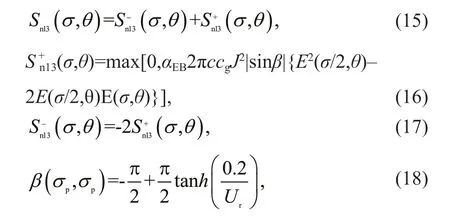
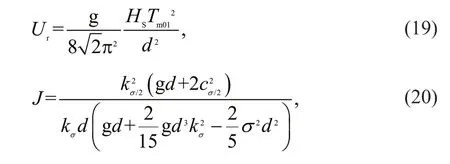
whereSnl3represents the nonlinear triad interactions,Urrepresents the local Ursell number,Eis the spectral energy,σpis the self-interaction of the peak frequency, andαEBis set to a constant 0.05.
3.2 Setup of the WW3 model
The 0.125°-gridded ECMWF winds, the 0.5°-gridded CFSv2 currents were taken as the forcing fi eld, and the GEBCO bathymetric data consisted of a 30 arc-second gird. These data were bilinearly interpolated into gridded data with a 1° spatial resolution. Thus, the WW3-simulated waves with a 1° grid are taken as the open boundary over the global seas.
The regional simulated area ranged from latitude 6°N to 44°N and longitude 111°E to 144°E. The ECMWF winds and GEBCO data were interpolated to 0.5° grids, which had the same spatial resolution as the NCEP CFSv2 current fi eld. The two-dimensional wave spectrum was resolved into 24 regular azimuthal directions, in which the wave frequency of the bins logarithmically ranged from 0.041 18 to 0.718 6 at an interval of Δf/f=0.1, and the time step of the spatial propagation was determined to be 300 s for both the latitudinal and longitudinal directions. The resolution of the model output was 0.1°-gridded.
4 RESULT
Figure 4 shows the daily average results of SWH from September 13 to 16, 2017, during which time the track of Typhoon Talim almost overlaid the Kuroshio. This fi gure shows that the high SWH appeared in the same area. As time passed, the high SWH area moved with the typhoon. In addition, it was found that the maximum SWH reached 10 m in the East China Sea on September 14, which was consistent with the maximum current speed for the region (about 1.5 m/s) induced by strong winds, as shown in Fig.5. Interestingly, the pattern of the simulated SWH was similar to that of current. Moreover, the SWH was larger to the east of Taiwan, China, than to the west, as can clearly be observed in Fig.5c & d. Figure 6 shows the average surface relative vorticity from September 13 to 16, the pattern of which was inconsistent with the simulated wave fi eld from the WW3 model. Interestingly, the tendency of surface relative vorticity area is inconsistent with that of the SWH. This phenomenon is clearly observed in the Fig.6a.
Figure 7 shows the average wave length at peak from September 13 to 16, which revealed that the average wave length distribution was inconsistent with the simulated wave fi eld from the WW3 model, particularly in Fig.7c & d. The average wave peak speed from September 13 to 16 is shown in Fig.8 and exhibited no obvious relationship with the simulated wave fi eld from the WW3 model. The average wave steep rate from September 13 to 16 displayed a high correlation with the simulated wave fi eld from the WW3 model, as shown in Fig.9. Overall, we determined that there is a positive correlation between surface current speeds and typhoon waves.
To better illustrate the relationship between surface current speed, e.g., Kuroshio and the wind-induce current, and SWH, we chose 6 points for further analysis. The geographic locations of these points are shown in Fig.10. The 2 points A and C are located to the east of Taiwan, China, where the Kuroshio exists. The 2 points B and D are located on either side of the track of Typhoon Talim in areas with maximum SWH. The last 2 points, E and F, are close to Japan, with F also located in the Kuroshio region. The black rectangle encloses the area used to generate the scatter plot shown in the Fig.11, which depicts the relationship between surface current speed and SWH. As shown in Fig.11a, the surface current speed and SWH have a correlation of 0.75. Thus, this indicates that the current speed is positively related to the typhoonassociated SWH. In the Fig.11b, we can fi nd that the surface current direction is not directly related with the typhoon-associated SWH. Moreover, it is no obvious relationship between surface current direction and wave direction in Fig.11c & d.
The relationship between surface current speed and SWH can be seen in Fig.12. At points A and C, located in the Kuroshio, it was found that the SWH exhibited a similar trend to that of the change in surface current speed during the duration of typhoon from September 11 to 20. This relationship is particularly evident in Fig.12b & d, when the SWH reached 11 m and the surface current speed exceeded 1 m/s. Although, the current speed were approximately 0.2 and 0.4 m/s at the beginning of Typhoon Talim for points A and C, respectively, the tendency of surface current is similar to that of the SWH. In addition, Fig.12c & e show the surface current speed to be around 0.5 m/s before September 11 without any strong wind-induced current, indicating that the surface current is to some extent related to the SWH. However, as shown in Fig.12a & f, the relationship between surface current and SWH is weak, and not signifi cant, at surface current speeds smaller than 0.2 m/s. Other points A, C, E, and F show less signifi cant relation between SWH and current, which is nearby the land. Collectively, these results indicate that the eff ect of surface current on wave simulation should be considered when the surface current speed is greaterthan 0.5 m/s. In particular, the wave-current interaction term is important for wave simulation in typhoons.
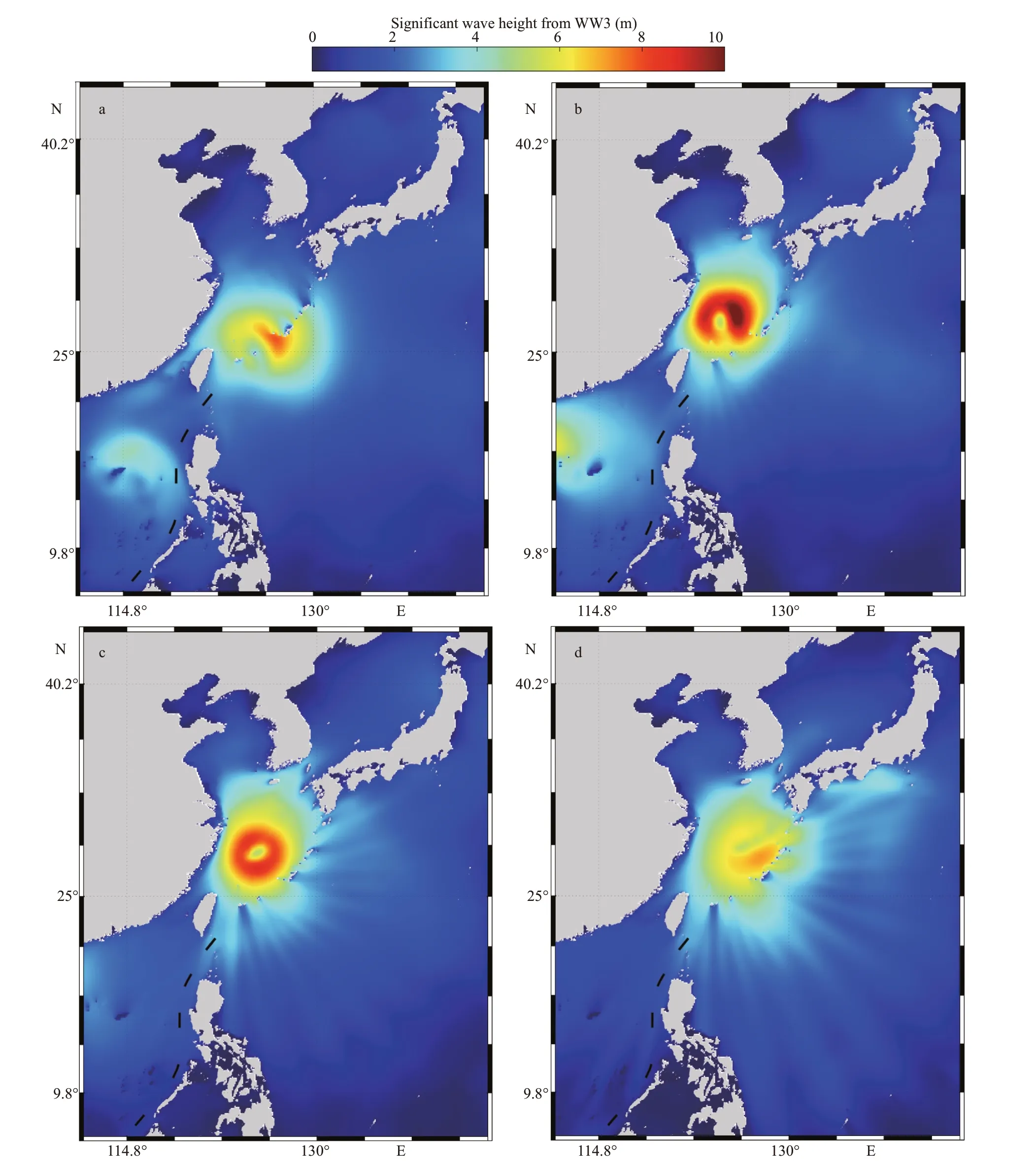
Fig.4 Average SWH on September 13 (a), September 14 (b), September 15 (c), and September 16 (d)

Fig.5 Average current speed provided by NCEP Climate Forecast System Version 2 (CFSv2) from 00:00 UTC September 13 to 00:00 UTC September 17, 2017
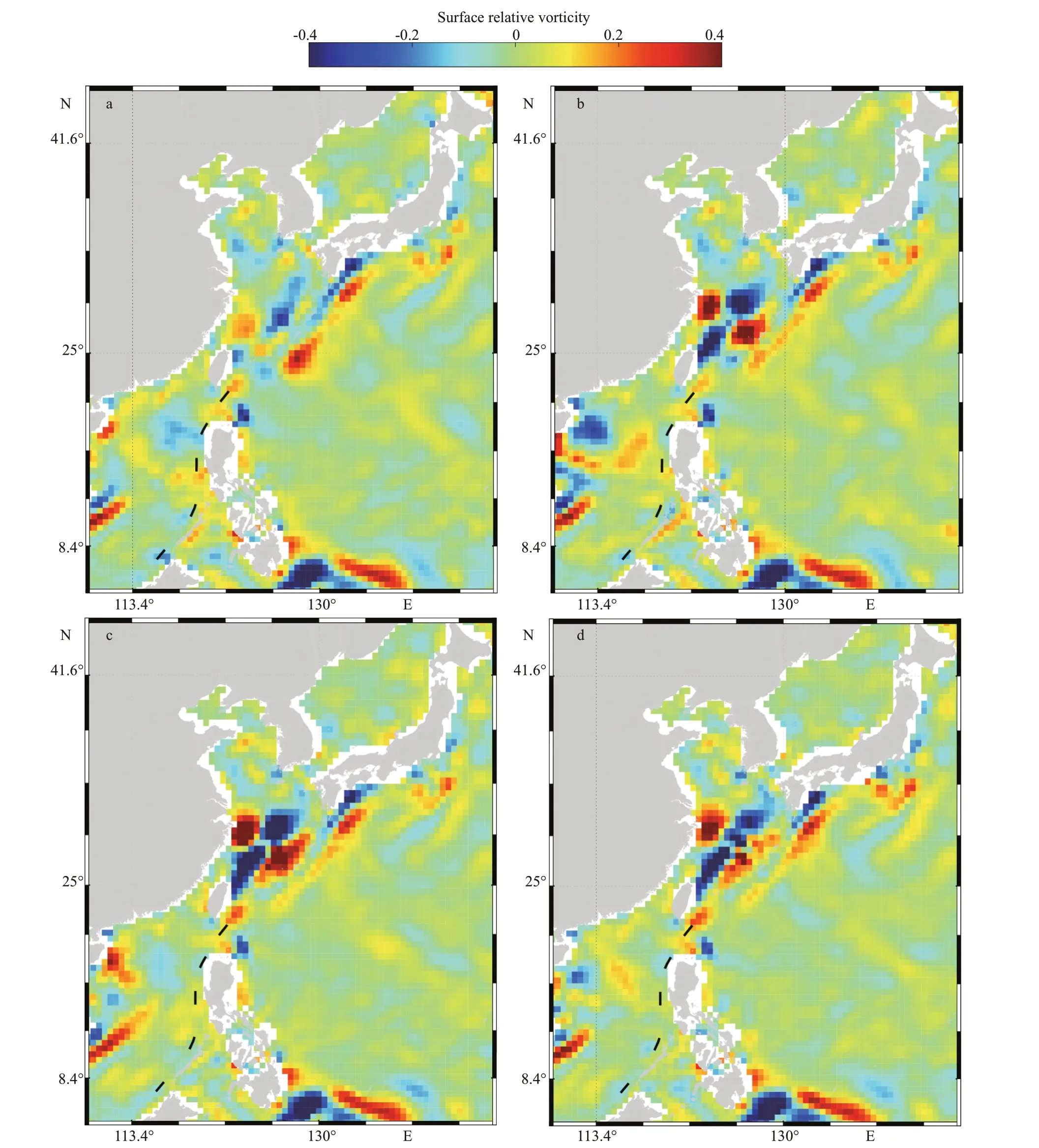
Fig.6 Average current surface relative vorticity, calculating by NCEP Climate Forecast System Version 2 (CFSv2) data, from 00:00 UTC September 13 to 00:00 UTC September 17, 2017
The wind-sea and swell data from the WW3 model can be simulated separately and widely used for studying the wind-sea and swell distributions across the global seas (Bi et al., 2015; Gallagher et al., 2016). To further study the interaction between surface current and wave, we divided the wave system into individual wind-sea and swell components. As an example, Fig.13 shows the average wind-sea SWH from the WW3 model. As seen in the fi gure, from September 14 the maximum wind-sea SWH reached nearly 8 m. Figure 14 shows the average swell SWH, for which the maximum swell SWH was less than 6 m. It was discovered that the wind-sea components dominate around the typhoon eye, while swells dominate outside the eye. It was also discovered that the distribution of surface current speed was consistent with that of wind-sea SWH in the East China Sea, a consistency that was particularly pronounced in Fig.13b & c.

Fig.7 Average wave length at peak from 00:00 UTC September 13 to 00:00 UTC September 17, 2017

Fig.8 Average wave peak speeds, calculating by the WW3 model data, from 00:00 UTC September 13 to 00:00 UTC September 17, 2017
The same points A–F were used to analyze windsea and swell against the backdrop of surface current over the entire duration of the typhoon, as shown in Figs.15 & 16, respectively. It can be clearly observed that the trend of the surface current was consistent with the wind-sea trend from September 13 to 16 in Fig.15b (point B) and d (point D). The relationship between swell and surface current speed, however, is messy, as shown in Fig.16b & d. At points C and E, swell dominates from 13 to 16 September, and the relationship between surface current and swell is weak. Again, there is no close correlation between the current and SWH at low current speeds (points A and F). This analysis demonstrates that the interaction of the surface current with the distribution of typhoon waves most likely derives from the wind-sea component of the wave system. Although the pattern of wind-induced current is consistent with that of wind-sea, the dynamics between surface currents and waves needs to be further studied because the processes in the interaction between wind-sea and current is complicated, e.g., exchange of energy, heat and spray.

Fig.9 Average wave steep rate, calculating by the WW3 model data, from 00:00 UTC September 13 to 00:00 UTC September 17, 2017
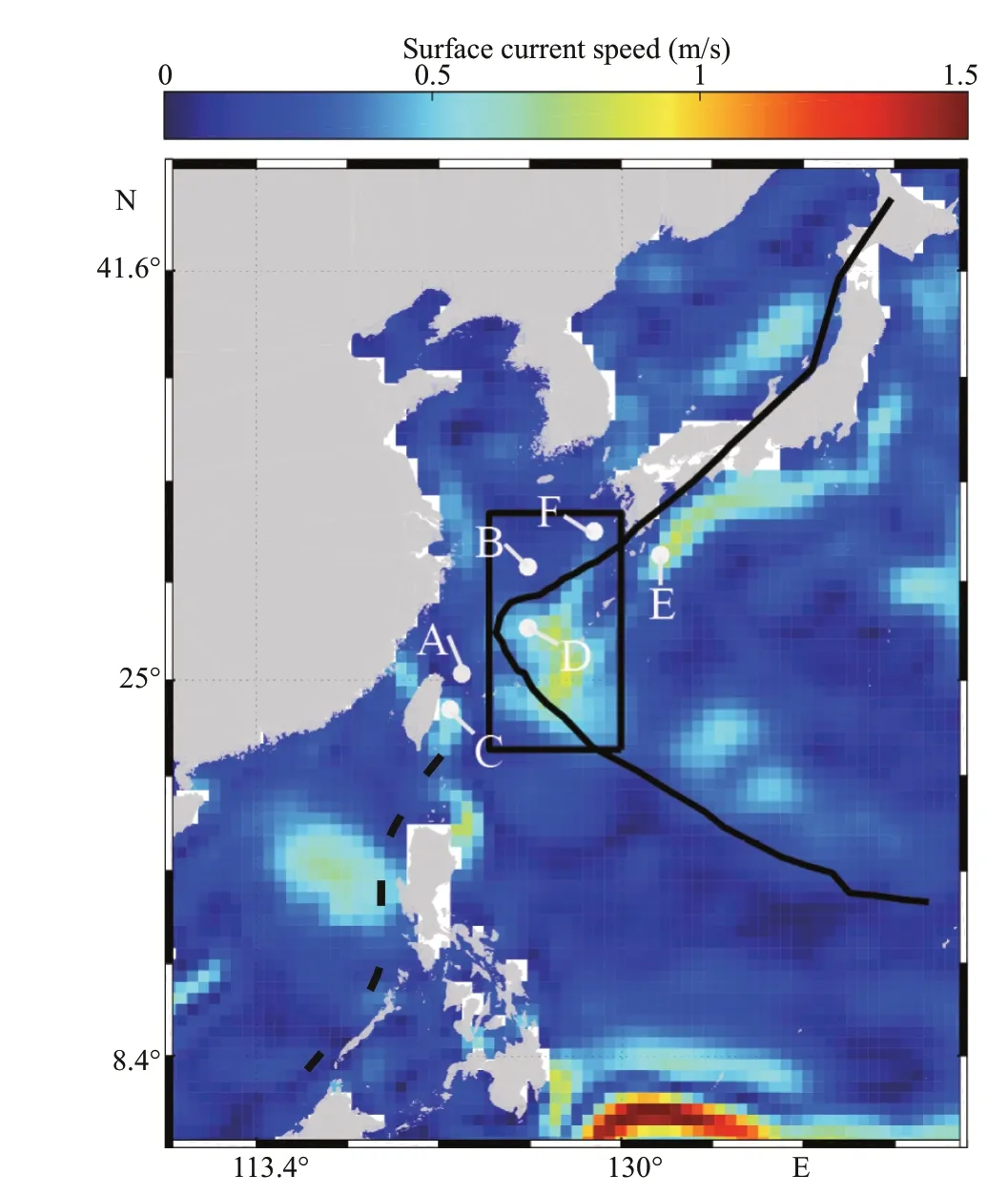
Fig.10 Average surface current speed provided by NCEP Climate Forecast System Version 2 (CFSv2), from September 13 to 17, 2017
5 CONCLUSION
Wave-current interactions are often ignored in wave simulations of typhoons. However, the Kuroshio plays an important role in the open sea of the western Pacifi c. In addition, strong winds in typhoons can induce currents. It was found that the track of Typhoon Talim was almost consistent with the Kuroshio from September 13 to 16, 2017. In this case study, we investigated the applicability of the latest version of the WW3 model (version 5.16) and analyzed typhooninduced waves while considering the surface current terms, including the Kuroshio and wind-induced current. It is noted that the wind-induced current (up to 1.5 m/s) was stronger than Kuroshio around typhoon eye. However, in regions far from the eye or with weak winds, the Kuroshio dominated.
In this study, SWHs were simulated using the WW3 model from August 1, 2017 to October 1 2018, including a term for the wave-current interaction. ECMWF winds on a 0.125°-grid and surface current data from CFSv2 on a 0.5 °-grid comprised the forcing fi eld. We used measurements from altimeter Jason-2 to validate the simulated SWH, which revealed a 0.34-m RMSE of SWH with a 0.45-m SI. It was observed that SWH is positively correlated with wind-induced current speed, while there is no relationship between SWH and several wave parameters, e.g., surface relative vorticity, wavelength at peak and wave peak speed. The trend of the Kuroshio was also consistent with the change of SWH and wave steep rate at current speeds greater than 0.5 m/s. However, it is diffi cult to draw any defi nitive conclusions for surface current speeds lower than 0.2 m/s.
The distributions of wind-sea and swell were analyzed in the context of surface current. The windsea pattern was consistent with the typhoon-induced surface current, while there was a weak relationship between surface current and swell. In summary, we conclude that there is a positive correlation between surface current speed, including that of the Kuroshio and strong wind-induced current, and typhoon waves. In the near future, we plan to simulate waves with the WW3 model in the context of surface currents, utilizing the various tracks of typhoons that have occurred over the past 20 years around the China Sea. The climate associated with typhoon-induced waves will be analyzed; in particular, the dynamics between surface currents and the development wind-sea components will be investigated in greater detail.
6 DATA AVAILABILITY STATEMENT
All data generated and/or analyzed during this study are available from the corresponding author on reasonable request.
7 ACKNOWLEDGMENT
We appreciate the National Centers for Environmental Prediction (NCEP) of the National Oceanic and Atmospheric Administration (NOAA) for providing the source code for the WAVEWATCH-III (WW3) model. The European Centre for Medium-Range Weather Forecasts (ECMWF) wind data were accessed via http://www.ecmwf.int. The General Bathymetry Chart of the Oceans (GEBCO) data were downloaded via: ftp.edcftp.cr.usgs.gov. Current fi eld data from the NCEP Climate Forecast System Version 2 (CFSv2) were collected via http://cfs.ncep.noaa.gov. The Operational Geophysical Data Record (OGDR) wave data from the altimeter Jason-2 mission were accessed via https://data.nodc.noaa.gov. Typhoon parameters were provided by the Japan Meteorological Agency (JMA) via http://www.jma.go.jp.
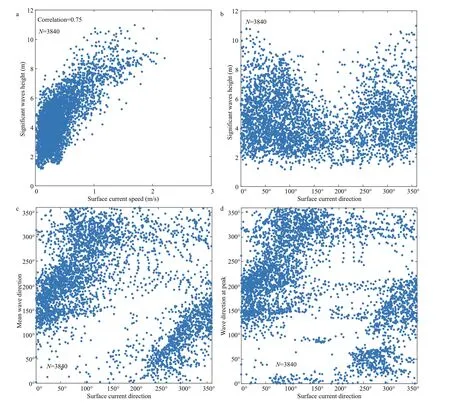
Fig.11 Comparison between surface current speed and SWH from the WW3 model (a); comparison between surface current direction and SWH from the WW3 model (b); comparison between surface current direction and mean wave direction from the WW3 model (c); comparison between surface current direction and wave direction at peak from the WW3 model (d)
References
Akpınar A, Van Vledder G P, Kömürcü M İ, Özger M. 2012. Evaluation of the numerical wave model (SWAN) for wave simulation in the Black Sea.ContinentalShelfResearch, 50-51: 80-99.
Bi F, Song J B, Wu K J, Xu Y. 2015. Evaluation of the simulation capability of the Wavewatch Ⅲ model for Pacifi c Ocean wave.ActaOceanologicaSinica, 34(9): 43-57.
Caruso M J, Gawarkiewicz G G, Beardsley R C. 2006. Interannual variability of the Kuroshio intrusion in the South China Sea.JournalofOceanography, 62(4): 559-575.
Cui H, He H L, Liu X H, Li Y. 2012. Eff ect of oceanic current on typhoon-wave modeling in the East China Sea.ChinesePhysicsB, 21(10): 109201.
Fan Y, Lin S J, Held I M, Yu Z T, Tolman H L. 2012. Global ocean surface wave simulation using a coupled atmospherewave model.JournalofClimate, 25(18): 6 233-6 252.

Fig.12 Relationship between signifi cant wave height and surface current speed with time from 00:00 UTC September 1 to 00:00 UTC September 21, 2017
Gallagher S, Gleeson E, Tiron R, Mcgrath R, Dias F. 2016. Wave climate projections for Ireland for the end of the 21stcentury including analysis of EC—Earth winds over the North Atlantic Ocean.InternationalJournalofClimatology, 36(14): 4 592-4 607.
Gallagher S, Tiron R, Dias F. 2014. A long-term nearshore wave hindcast for Ireland: Atlantic and Irish Sea coasts (1979-2012).OceanDynamics, 64(8): 1 163-1 180.
Guo L L, Perrie W, Long Z C, Toulany B, Sheng J Y. 2018. The impacts of climate change on the autumn North Atlantic wave climate.Atmosphere-Ocean, 53(5): 491-509.
Hasselmann S, Hasselmann K, Allender J H, Barnett T P. 1985. Computations and parameterizations of the nonlinear energy transfer in a gravity-wave spectrum. Part II: Parameterizations of the nonlinear energy transfer for application in wave models.JournalofPhysicalOceanography, 15(11): 1 378-1 391.
He H L, Song J B, Bai Y, Xu Y, Wang J J, Fan B. 2018. Climate and extrema of ocean waves in the East China Sea.ScienceChinaEarthSciences, 61(7): 980-994.
He H L, Xu Y. 2016. Wind-wave hindcast in the Yellow Sea and the Bohai Sea from the year 1988 to 2002.ActaOceanologicaSinica, 35(3): 46-53.
Herterich K, Hasselmann K. 1980. A similarity relation for the nonlinear energy transfer in a fi nite-depth gravity-wave spectrum.JournalofFluidMechanics, 97(1): 215-224.
Ji Q Y, Shao W Z, Sheng Y X, Yuan X Z, Sun J, Zhou W, Zuo J C. 2018. A promising method of typhoon wave retrieval from Gaofen-3 synthetic aperture radar image in VVpolarization.Sensors, 18(7): 2 064.
Jiang C B, Zhao B B, Deng B, Wu Z Y. 2017. Numerical simulation of typhoon storm surge in the Beibu Gulf and hazardous analysis at key areas.MarineForecasts, 3 4(3): 32-40. (in Chinese with English abstract)
Kim T R, Lee J H. 2018. Comparison of high wave hindcasts during Typhoon Bolaven (1215) using SWAN and WAVEWATCH III model.JournalofCoastalResearch, 85(sp1): 1 096-1 100.
Li S Q, Guan S D, Hou Y J, Liu Y H, Bi F. 2018. Evaluation and adjustment of altimeter measurement and numerical hindcast in wave height trend estimation in China’s coastal seas.InternationalJournalofAppliedEarthObservationandGeoinformation, 67: 161-172.
Li X F. 2015. The fi rst Sentinel-1 SAR image of a typhoon.ActaOceanologicaSinica, 34(1): 1-2.
Liu Q X, Babanin A V, Zieger S, Young I R, Guan C L. 2016. Wind and wave climate in the Arctic ocean as observed by altimeters.JournalofClimate, 29(22): 7 957-7 975.
Moeini M H, Etemad-Shahidi A, Chegini V. 2010. Wave modeling and extreme value analysis off the northern coast of the Persian Gulf.AppliedOceanResearch, 32(2): 209-218.
Montoya R D, Arias A O, Royero J C O, Ocampo-Torres F J. 2013. A wave parameters and directional spectrum analysis for extreme winds.OceanEngineering, 67: 100-118.

Fig.14. Averaged swell signifi cant wave height from September 13 to September 16, 2017
Moon I J. 2005. Impact of a coupled ocean wave-tidecirculation system on coastal modeling.OceanModelling, 8(3): 203-236.
Shao W Z, Hu Y Y, Yang J S, Nunziata F, Sun J, Li H, Zuo J C. 2018a. An empirical algorithm to retrieve signifi cant wave height from Sentinel-1 synthetic aperture radar imagery collected under cyclonic conditions.RemoteSensing, 10(7): 1 367.
Shao W Z, Li X F, Hwang P A, Zhang B, Yang X F. 2017. Bridging the gap between cyclone wind and wave by C-band SAR measurements.JournalofGeophysicalResearch:Oceans, 122(8): 6 714-6 724.

Fig.15 Relationship between wind-sea signifi cant wave height and surface current speed with time from September 1 to 21, 2017
Shao W Z, Sheng Y X, Li H, Shi J, Ji Q Y, Tai W, Zuo J C. 2018b. Analysis of wave distribution simulated by WAVEWATCH-III model in typhoons passing Beibu Gulf, China.Atmosphere, 8(7): 265.
Sheng Y X, Shao W Z, Li S Q, Zhang Y M, Yang H W, Zuo J C. 2018. Evaluation of typhoon waves simulated by WaveWatch-III model in shallow waters around Zhoushan islands.JournalofOceanUniversityofChina, 18(2): 365-375.
Shukla R P, Kinter J L, Shin C S. 2018. Sub-seasonal prediction of signifi cant wave heights over the Western Pacifi c and Indian Oceans, part II: The impact of ENSO and MJO.OceanModelling, 123: 1-15.
Stopa J E, Cheung K F. 2014. Intercomparison of wind and wave data from the ECMWF reanalysis interim and the NCEP climate forecast system reanalysis.OceanModelling, 75: 65-83.
The WAMDI Group. 1988. The WAM Model—a third generation ocean wave prediction model.JournalofPhysicalOceanography, 18(12): 1 775-1 810.
The WAVEWATCH III Development Group (WW3DG). 2016. User Manual and System Documentation of WAVEWATCH III Version 5. 16. 329p; Technical Note, MMAB Contribution; NOAA/NWS/NCEP/MMAB: College Park, MD, USA; Volume 276, 326p.
Tolman H L. 2002. Validation of WAVEWATCH III Version 1.15 for a Global Domain. NCEP Technical Note 213. National Oceanic and Atmospheric Administration, Camp Springs, US. 213p.
Tolman H L, Chalikov D V. 1996. Source terms in a thirdgeneration wind wave model.JournalofPhysicalOceanography, 26(11): 2 497-2 518.
Weatherall P, Marks K M, Jakobsson M, Schmitt T, Tani S, Arndt J E, Rovere M, Chayes D, Ferrini V, Wigley R. 2015. A new digital bathymetric model of the world’s oceans.EarthandSpaceScience, 2(8): 331-345.
Zheng K W, Sun J, Guan C L, Shao W Z. 2016. Analysis of the global swell and wind sea energy distribution using WAVEWATCH III.AdvancesinMeteorology, 2016: 8419580.
Zheng K W, Osinowo A A, Sun J, Hu W. 2018. Long-term characterization of sea conditions in the East China Sea using signifi cant wave height and wind speed.JournalofOceanUniversityofChina, 17(4): 733-743.
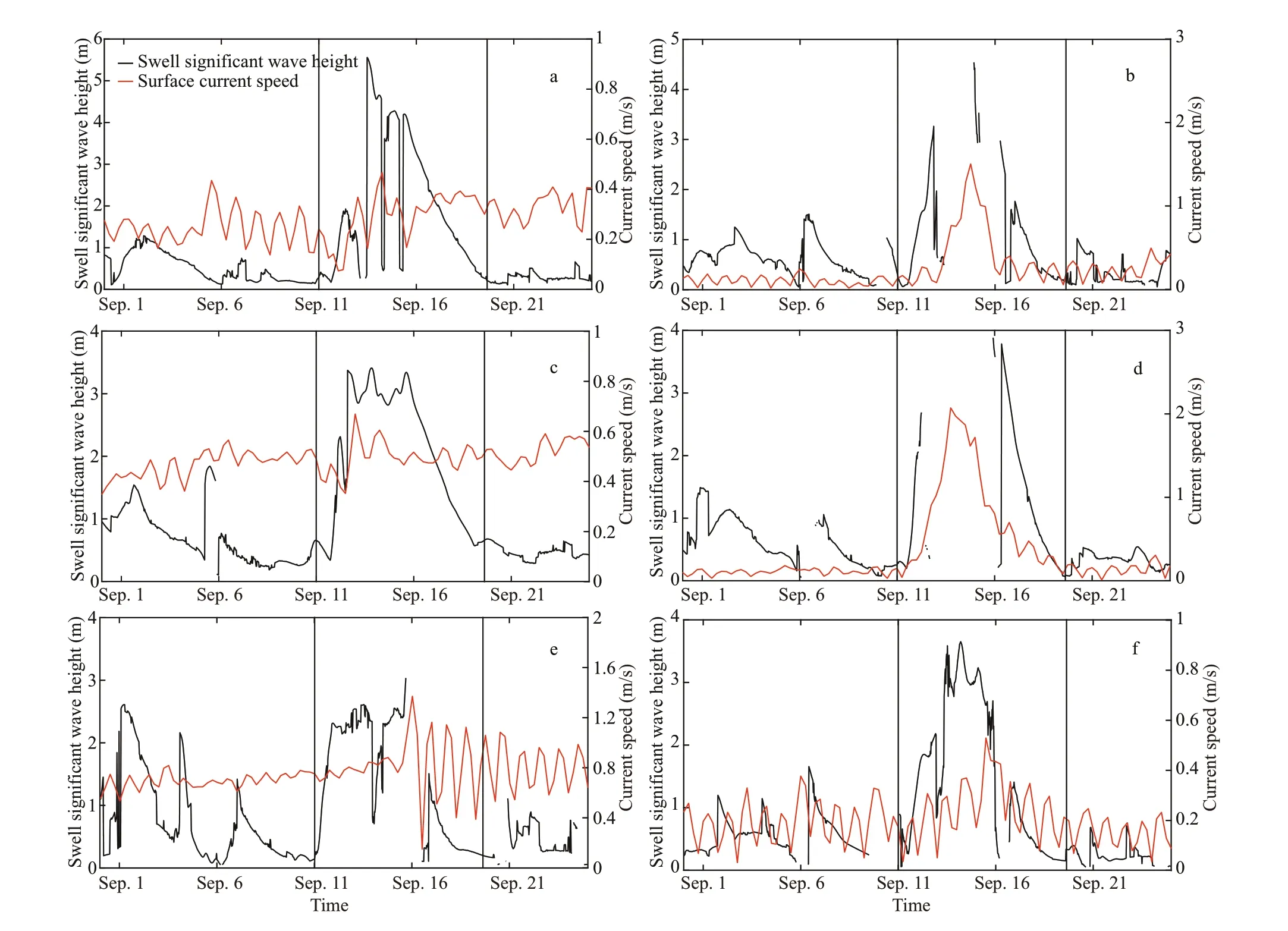
Fig.16 Relationship between swell signifi cant wave height and surface current speed with time from September 1 to 21, 2017
 Journal of Oceanology and Limnology2020年6期
Journal of Oceanology and Limnology2020年6期
- Journal of Oceanology and Limnology的其它文章
- Eff ects of vitamin C defi ciency or excess on growth performance, anti-oxidative response and fatty acid composition of juvenile abalone Haliotis discu s hannai Ino*
- Leptolaimus holovachovi sp. nov. (Nematoda) from Shenzhen Mangrove Nature Reserve, Shenzhen, South China*
- Profi le and development of microsatellite primers for Acanthogobius ommaturus based on high-throughput sequencing technology*
- Digging out molecular markers associated with low salinity tolerance of Nannochloropsis oceanica through bulked mutant analysis*
- An enhanced underwater camera apparatus for seabed observation of megabenthic epifauna in the northern Yellow Sea*
- Characteristics of zooplankton community in North Yellow Sea unveiled an indicator species for the Yellow Sea Warm Current in winter: Euchaeta plana*
